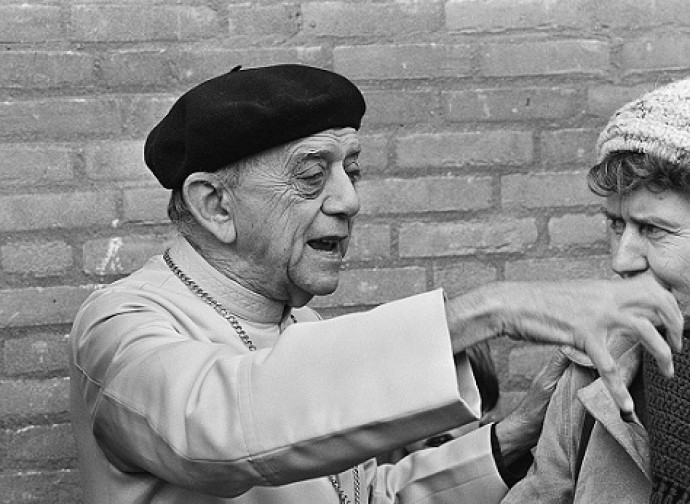"To canonise Camara is to canonise communism”
Dom Helder Camara could soon be declared venerable. Protagonist of liberation theology, sympathetic towards the USSR and China, revolutionary armed struggle was planned in his diocese. A "media and ideological", rather than a religious saint, Julio Loredo, president of the Italian TFP, tells The Compass.

There has been a decisive step forward for the cause of beatification of Msgr Helder Camara (1909-1999), the Brazilian 'red bishop' who could soon be declared venerable. The announcement was made by Archbishop Fernando Saburido, his successor in the archdiocese of Olinda and Recife, governed by Camara between 1964 and 1985. A prelate sui generis, sided with the more progressive wing of the Council Fathers and then, when the Council was over, eager for a Vatican III that would outdo its predecessor (to the left, naturally). Protagonist of the theology of liberation, on the political level he was decidedly supportive of communist dictatorships, from the Soviet Union, to China, to Cuba, always under the banner of the 'defence of the poor' with which he was propagandistically identified in life and in death. Should Monsignor Camara one day achieve sainthood, he would be a controversial model, to say the least. Claiming this, and hoping that the cause will be suspended, is Tradition, Family, and Property (TFP), a network of associations born in Brazil from the work of Plinio Corrêa de Oliveira (1908-1995), a Catholic leader, committed to the 'cultural battle' on positions opposite to those of Dom Camara. Julio Loredo, president of the Italian TFP, talks about this with The Daily Compass.
Loredo, could we have a 'red bishop' as a saint?
Dom Helder Camara was a key figure of ecclesial progressivism from the 1930s until his death, a protagonist of the leftward turn of Catholic Action in Brazil. Liberation theology also emerged as part of this process. Moreover, in the 1950s and 1960s, he played a central role in the (generational but also ideological) replacement of the Brazilian episcopate, favouring the appointment of progressive prelates together with the nuncio of the time, Msgr Armando Lombardi.
A parabola that started, however, from the opposite front....
And not as a simple militant: he was number two in the pro-Nazi party Brazilian Integralist Action, founded by Plinio Salgado. When he was ordained a priest in 1931, he wore the uniform of the integralist militia under his cassock. Thanks to a study by Plinio Correa de Oliveira, which showed its incompatibility with Catholic doctrine, ecclesiastical support for the movement, which was later outlawed by President Getulio Vargas, was withdrawn. After its dissolution and the exile of Salgado, Camara began his ideological shift to the left - which we described at the beginning - to the theology of liberation and the constitution of Basic Ecclesial Communities (CEB), prefigured by the Marxist Brazilian pedagogue Paulo Freire, inspirer of the Movimento de Educação de Base.
How did Dom Camara behave during the Council?
Although he never spoke in the chamber, he was absolutely central behind the scenes of Vatican II. It was he who coordinated the meetings between exponents of the progressive wing (curiously enough, even on the traditionalist front the push came from Brazil, thanks to the meetings coordinated by Plinio Correa de Oliveira, from which the Coetus Internationalis Patrum emerged). During these years, Dom Helder, already an integral part of liberation theology, continued his dissent with the magisterium also on the moral level, including criticism of Paul VI's Humanae Vitae and the defence of abortion.
A politician rather than a bishop?
In 1969 he gave a famous speech in New York in which he supported international communism. He defended the USSR and Mao's China. One of the most shocking episodes dates back to 1968: the Comblin document. In June 1968, a document revealed that an armed communist revolution in Brazil was planned. Joseph Comblin was a Belgian priest, professor at the Recife Theology Institute. So this was in the diocese and under the aegis of Msgr Camara, who did not deny the authenticity of the document, merely saying that it was unofficial. The project envisioned, for example, the abolition of private property and of the armed forces; censorship of the press, radio, and TV; and people's courts. In practice a Bolshevik revolution in Brazil. Correa de Oliveira collected two million signatures asking for Paul VI's intervention to block this Marxist infiltration into the Brazilian Church, but received no response
In fact, the controversial prelate remained in office until the canonical age of 75.
In 1984, John Paul II appointed his successor José Cardoso Sobrinho, who tried to bring some order to the diocese, even closing the Theology Institute and creating another. In the same year, the Vatican instruction Libertatis Nuntius came out, condemning the external aspects of liberation theology, but it was like closing the stable door when the horse has already bolted.
And he personally never recanted his positions?
Not as far as we know. And when he died in August 1999, he enjoyed a kind of media canonisation. Some Italian newspapers headlined: 'Prophet of the poor', 'Saint of the favelas', 'Voice of the Third World', and even 'Saint Helder of America'.
An ideological, rather than religious, 'fame of sanctity'.
Should Dom Helder Camara be canonised it would also be the canonisation of communism, of liberation theology, of dissent. They already call him the 'Saint of the poor', but he defended regimes that cause poverty, as Indro Montanelli summarised: “The left loves the poor so much that every time it comes to power it increases their number”. With regard to the 'falsification of the Christian faith' operated by liberation theology, Benedict XVI said that “one must also oppose it out of love for the poor and for the service that must be rendered to them”.




